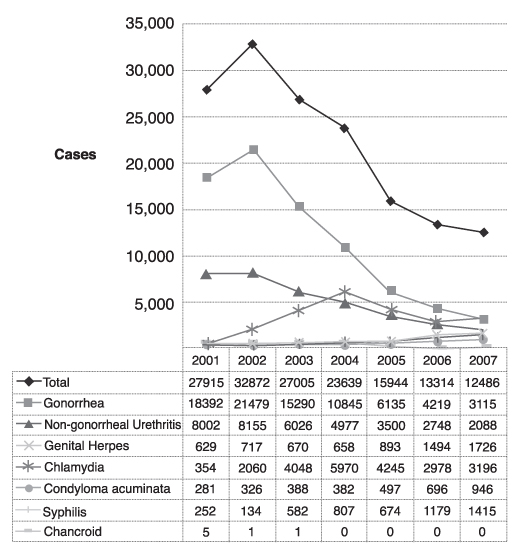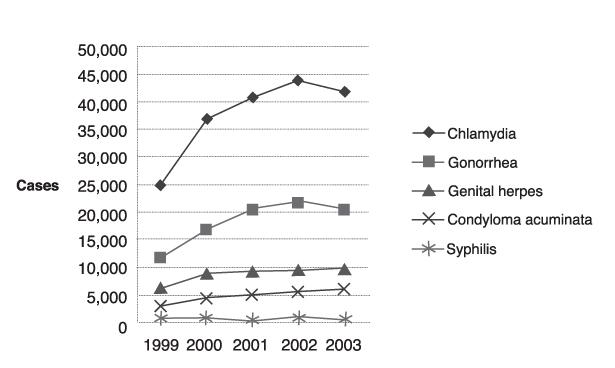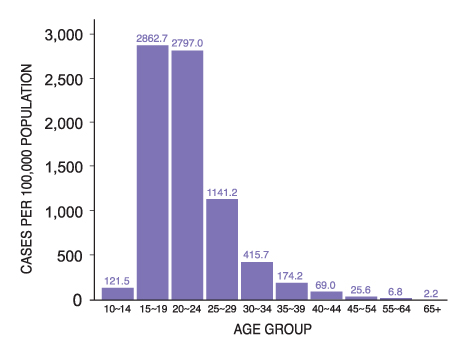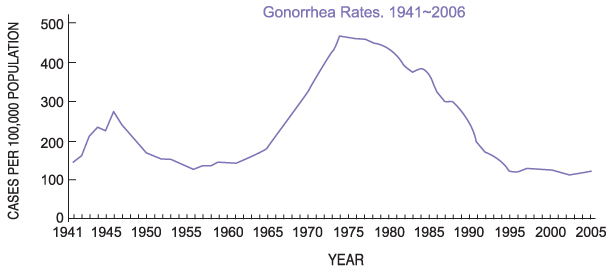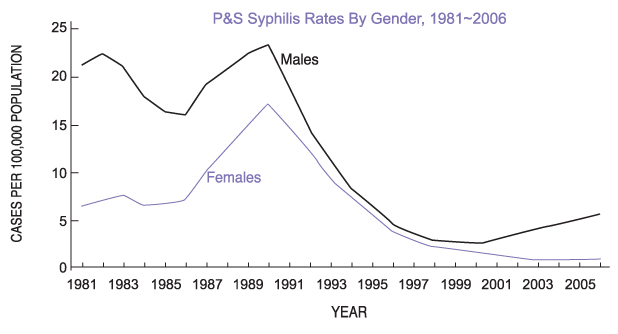Historical Changes and the Present Situation of Sexually Transmitted Diseases
- Affiliations
-
- 1Department of Obstetrics and Gynecology, Soonchunhyang University College of Medicine, Korea. islee@hosp.sch.ac.kr
- KMID: 2065026
- DOI: http://doi.org/10.5124/jkma.2008.51.10.868
Abstract
- STDs (sexually transmitted diseases) refer to a variety of bacterial, viral, and parasitic infections that are acquired through sexual activity including vaginal intercourse, oral sex, and anal sex. The term sexually transmitted infection (STI) is used increasingly because it has a broader range of meaning; a person may be infected and may potentially infect others without showing signs of diseases. Approximately 340 million new cases of STDs occur each year in the world. According to the Korea Centers for Disease Control and Prevention, notified cases of STDs in Korea decreased from 32,872 in 2002 to 12,486 in 2007. Bacterial STDs such as gonorrhea and chlamydial infection declined continuously but syphilis and chlamydial infection increased again. Viral STDs such as genital herpes and condyloma acuminatum increased continuously. Gonorrhea and chlamydial infection are still the two most commonly reported STDs in Korea. Bacterial STDs can be cured. However, the problem is that viral STDs cannot be cured completely at present. Safe sex with proper education and the correct use of condom are important to prevent STDs and unwanted pregnancy. Early diagnosis and screening, proper treatment, and appropriate counseling from qualified physicians are necessary to prevent the complications and spread of STDs. Also, continuous monitoring and strategies of prevention of STDs will be necessary for improvement of the public health.
MeSH Terms
Figure
Cited by 4 articles
-
History of Syphilis and Gonorrhea in Korea
Jae-Ki Choi, Seung-Ju Lee, Jin-Hong Yoo
Infect Chemother. 2019;51(2):210-216. doi: 10.3947/ic.2019.51.2.210.Clinical Usefulness of a DNA Microarray-based Assay for the Diagnosis of Sexually Transmitted Infections
Ae Ja Park, So Young Kim, Dong Hee Seo
Lab Med Online. 2016;6(3):171-175. doi: 10.3343/lmo.2016.6.3.171.Highly Sensitive and Novel Point-of-Care System, aQcare Chlamydia TRF Kit for Detecting
Chlamydia trachomatis by Using Europium (Eu) (III) Chelated Nanoparticles
Ji Yeon Ham, Jaean Jung, Byung-Gap Hwang, Won-Jung Kim, Young-Seop Kim, Eun-Ju Kim, Mi-Yeon Cho, Mi-Sun Hwang, Dong Il Won, Jang Soo Suh
Ann Lab Med. 2015;35(1):50-56. doi: 10.3343/alm.2015.35.1.50.A Case of Herpes Simplex Virus Type 2 Encephalitis of a Newborn Delivered by a Mother without Prenatal Screening
Eun Seob Lee, Joon Young Kim, Kon Hee Lee, Jung Won Lee, Yong Ju Lee, Yeon Joung Oh, Ji Seok Bang, Tae-Jung Sung
Korean J Perinatol. 2014;25(3):195-201. doi: 10.14734/kjp.2014.25.3.195.
Reference
-
1. Lee JK. Report from a Korea Centers for Disease Control and Prevention 2007. KCDC. 2008. 98:127–130.2. Choi JH, Jeung IC, Pak YG, Park DC. Prevalence and risk factors of chlamydia trachomatis and neisseria gonorrhea among Korean women. Korean J Obstet Gynecol. 2007. 12:1739–1746.3. Song HJ, Jeon DY, Shin MY, Park SS, Kim CM, Heo NC. Seroprevalence of human herpes simplex virus-2 in Jeollanam-do. 2005.4. WHO. Global strategy for prevention and control of sexually transmitted infections. 2007. 2006–2015.5. Matsuda NO. Trend of STD 2005. World of Obstet Gynecol. 2005. 57:1033–1044.6. CDC. Trends in reportable sexually transmitted diseases in the United States, 2006. Sexually Transmitted Disease Surveillance 2006.7. CDC. Sexually transmitted diseases treatment guidelines, 2006. MMWR. 2006. 55(No. RR-11):

